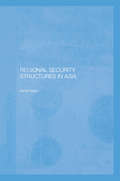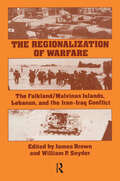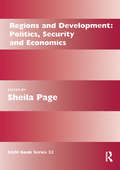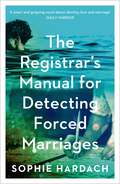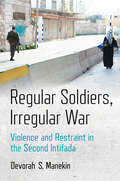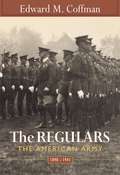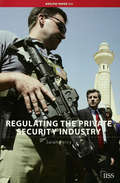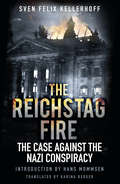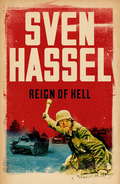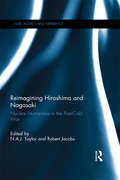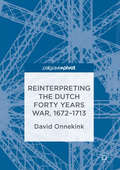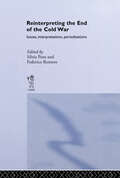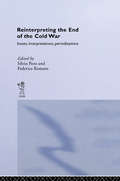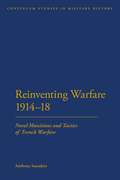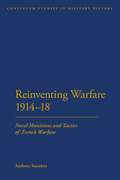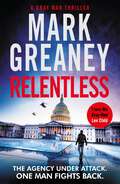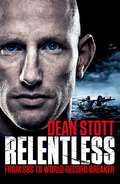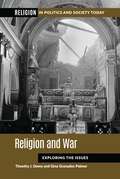- Table View
- List View
Regional Security Structures in Asia
by Ashok KaporKapor argues that explanations of international relations in Asia in the post-Second World War period have relied too much on the Cold War as a key explanatory factor, and have not given enough emphasis to the useful concepts of 'regional power formation', 'conflict formation' and 'conflict resolution'. The author outlines these concepts and goes on to elaborate on them, and to apply them to three key Asian regions - northeast, southeast, and south Asia - discussing practical strategic issues in an historical perspective and arguing that these concepts, and other concepts which he discusses, are extremely helpful in making sense of the complex pattern of international relations in Asia.
Regional Security Structures in Asia
by Ashok KaporKapor argues that explanations of international relations in Asia in the post-Second World War period have relied too much on the Cold War as a key explanatory factor, and have not given enough emphasis to the useful concepts of 'regional power formation', 'conflict formation' and 'conflict resolution'. The author outlines these concepts and goes on to elaborate on them, and to apply them to three key Asian regions - northeast, southeast, and south Asia - discussing practical strategic issues in an historical perspective and arguing that these concepts, and other concepts which he discusses, are extremely helpful in making sense of the complex pattern of international relations in Asia.
The Regionalization of Warfare: The Falkland/Malvinas Islands, Lebanon, and the Iran-Iraq Conflict
by James Brown William P. SnyderThree wars have dominated world events in recent years: The conflict which erupted between the United Kingdom and Argentina over the Falkland/Malvinas Islands; the multinational conflict in Lebanon involving Irsaeli, Syrian, and FLO forces in Lebanon; and the savage struggles between ground and air units of the Iranian and Iraqi forces. The scale and intensity of these wars, their potential for global conflict, make them crucial for an understanding among citizens in general, and defense and political analysts in particular.The authors and contributors to this most unusual volume come to several common conclusions: professionalism is a crucial factor in military effectiveness, but not necessarily dependent on modes of recruitment; high technology is crucial, but only in relation to the quality and training of the personnel; public support is necessary to sustain military morale in democratic and authoritarian regimes alike. These are only some of the incisive findings registered and explored in The Regionalization of Warfare.The volume a'ssembles experts not only on these three major regional and interregional conflicts, but on current U.S. defense policies; Soviet strategic interests in Middle East and Persian Gulf conflicts; and a series of papers on lessons learned and unlearned as a result of these "small wars" of the early 1980s. For those interested in military history, global strategy, and regional rivalries, this -collection of finely written, sophisticated papers will prove to be of intense concern.
The Regionalization of Warfare: The Falkland/Malvinas Islands, Lebanon, and the Iran-Iraq Conflict
Three wars have dominated world events in recent years: The conflict which erupted between the United Kingdom and Argentina over the Falkland/Malvinas Islands; the multinational conflict in Lebanon involving Irsaeli, Syrian, and FLO forces in Lebanon; and the savage struggles between ground and air units of the Iranian and Iraqi forces. The scale and intensity of these wars, their potential for global conflict, make them crucial for an understanding among citizens in general, and defense and political analysts in particular.The authors and contributors to this most unusual volume come to several common conclusions: professionalism is a crucial factor in military effectiveness, but not necessarily dependent on modes of recruitment; high technology is crucial, but only in relation to the quality and training of the personnel; public support is necessary to sustain military morale in democratic and authoritarian regimes alike. These are only some of the incisive findings registered and explored in The Regionalization of Warfare.The volume a'ssembles experts not only on these three major regional and interregional conflicts, but on current U.S. defense policies; Soviet strategic interests in Middle East and Persian Gulf conflicts; and a series of papers on lessons learned and unlearned as a result of these "small wars" of the early 1980s. For those interested in military history, global strategy, and regional rivalries, this -collection of finely written, sophisticated papers will prove to be of intense concern.
Regions and Development: Politics, Security and Economics (Routledge Research EADI Studies in Development)
by Sheila PageAt the 1996 EADI Conference, the papers presented in the World Trade and Trade Policy workshop looked at the new trends in regionalism from a variety of points of view for different institutions. They considered the effects of regions, their implications for policy and performance in the developing countries and for international economic institutions, and tried to interpret them in terms of economic and political theory.
Regions and Development: Politics, Security and Economics (Routledge Research EADI Studies in Development)
by Sheila PageAt the 1996 EADI Conference, the papers presented in the World Trade and Trade Policy workshop looked at the new trends in regionalism from a variety of points of view for different institutions. They considered the effects of regions, their implications for policy and performance in the developing countries and for international economic institutions, and tried to interpret them in terms of economic and political theory.
The Registrar's Manual for Detecting Forced Marriages
by Sophie HardachThe compelling and original debut novel from the Costa Prize-shortlisted author of Confession with Blue Horses.Swimming for his life towards traffickers on the Italian shore, Selim enters a world where Kurdish refugees disguise themselves as tomatoes, dates of birth are a matter of opinion, and a residency permit is a ticket to paradise. When he ends up in a small town in Germany, Selim believes he is finally safe, until the law catches up with him and the clock starts ticking. Selim realises there is only one way to avoid deportation...Fifteen years later, in a town hall in Paris, a Registrar receives an unsettling book: 'The Registrar's Manual for Detecting Forced Marriages' fuels her suspicions surrounding an impending Kurdish wedding. She embarks on an investigation that will bring her uncomfortably close to an old acquaintance.Written with real imaginative flair, heart and humour, The Registrar's Manual for Detecting Forced Marriages introduces an unlikely hero who'll prove impossible to forget, and a prodigious new talent in Sophie Hardach.
Regular Soldiers, Irregular War: Violence and Restraint in the Second Intifada
by Devorah S. ManekinWhat explains differences in soldier participation in violence during irregular war? How do ordinary men become professional wielders of force, and when does this transformation falter or fail? Regular Soldiers, Irregular War presents a theoretical framework for understanding the various forms of behavior in which soldiers engage during counterinsurgency campaigns—compliance and shirking, abuse and restraint, as well as the creation of new violent practices.Through an in-depth study of the Israeli Defense Forces' repression of the Second Palestinian Intifada of 2000–2005, including in-depth interviews with and a survey of former combatants, Devorah Manekin examines how soldiers come both to unleash and to curb violence against civilians in a counterinsurgency campaign. Manekin argues that variation in soldiers' behavior is best explained by the effectiveness of the control mechanisms put in place to ensure combatant violence reflects the strategies and preferences of military elites, primarily at the small-unit level. Furthermore, she develops and analyzes soldier participation in three categories of violence: strategic violence authorized by military elites; opportunistic or unauthorized violence; and "entrepreneurial violence"—violence initiated from below to advance organizational aims when leaders are ambiguous about what will best serve those aims. By going inside military field units and exploring their patterns of command and control, Regular Soldiers, Irregular War, sheds new light on the dynamics of violence and restraint in counterinsurgency.
The Regulars: The American Army, 1898-1941
by Edward M. CoffmanIn 1898 the American Regular Army was a small frontier constabulary engaged in skirmishes with Indians and protesting workers. Forty-three years later, in 1941, it was a large modern army ready to wage global war against the Germans and the Japanese. In this definitive social history of America's standing army, military historian Edward Coffman tells how that critical transformation was accomplished. Coffman has spent years immersed in the official records, personal papers, memoirs, and biographies of regular army men, including such famous leaders as George Marshall, George Patton, and Douglas MacArthur. He weaves their stories, and those of others he has interviewed, into the story of an army which grew from a small community of posts in China and the Philippines to a highly effective mechanized ground and air force. During these years, the U.S. Army conquered and controlled a colonial empire, military staff lived in exotic locales with their families, and soldiers engaged in combat in Cuba and the Pacific. In the twentieth century, the United States entered into alliances to fight the German army in World War I, and then again to meet the challenge of the Axis Powers in World War II. Coffman explains how a managerial revolution in the early 1900s provided the organizational framework and educational foundation for change, and how the combination of inspired leadership, technological advances, and a supportive society made it successful. In a stirring account of all aspects of garrison life, including race relations, we meet the men and women who helped reconfigure America's frontier army into a modern global force.
Regulating the Private Security Industry: Regulating The Private Security Industry (Adelphi series)
by Sarah PercyThe under-regulation of the private security industry has increasingly become a topic of media and academic interest. This Adelphi Paper enters the debate by explaining why the industry requires further regulation, and what is wrong with the current system. It begins by briefly defining the industry and explaining the need for more effective regulation, before analysing three types of regulation: domestic, international and informal (including self-regulation).
Regulating the Private Security Industry (Adelphi series)
by Sarah PercyThe under-regulation of the private security industry has increasingly become a topic of media and academic interest. This Adelphi Paper enters the debate by explaining why the industry requires further regulation, and what is wrong with the current system. It begins by briefly defining the industry and explaining the need for more effective regulation, before analysing three types of regulation: domestic, international and informal (including self-regulation).
Reich: World War II Through German Eyes (Osprey Digital Generals Ser.)
by James LucasWhile Allied propaganda would have us believe that during World War II the German population were downtrodden workers, with no rights and under the power and influence of the all-controlling Gestapo, the truth is somewhat different. While the Allies saw Hitler as an evil to be removed from power, in 1933 the German people saw him as a saviour, able to rescue them from the humiliation the Treaty of Versailles imposed on them. In the early days of the Nazi regime, the German people widely felt that they had social benefits unmatched by its neighbouring states, and that its poverty had been eliminated while its economy had been stabilised. James Lucas presents a fascinating insight into the real Reich, a glimpse into the life on the German home front, from the role of women to the propaganda machine, assessing the German view of how the war would be fought, and how Hitler directly intervened in all level of party politics and decisions. Case studies of operations Barbarossa and Sealion provide an insight into military decisions of a wider scale. After many years' research and interviews with civilians and German soldiers, Reich offers a study of the social, economic and military phenomena of the Nazi regime.
Reich: World War II Through German Eyes
by James LucasWhile Allied propaganda would have us believe that during World War II the German population were downtrodden workers, with no rights and under the power and influence of the all-controlling Gestapo, the truth is somewhat different. While the Allies saw Hitler as an evil to be removed from power, in 1933 the German people saw him as a saviour, able to rescue them from the humiliation the Treaty of Versailles imposed on them. In the early days of the Nazi regime, the German people widely felt that they had social benefits unmatched by its neighbouring states, and that its poverty had been eliminated while its economy had been stabilised. James Lucas presents a fascinating insight into the real Reich, a glimpse into the life on the German home front, from the role of women to the propaganda machine, assessing the German view of how the war would be fought, and how Hitler directly intervened in all level of party politics and decisions. Case studies of operations Barbarossa and Sealion provide an insight into military decisions of a wider scale. After many years' research and interviews with civilians and German soldiers, Reich offers a study of the social, economic and military phenomena of the Nazi regime.
The Reichstag Fire: The Case Against the Nazi Conspiracy
by Sven Felix KellerhoffWho really caused the Reichstag fire on the evening of 27 February 1933? Were the Nazis really to blame? The debate has been going on for over eighty years as to who started the Reichstag fire and, in turn, became the catalyst of the Nazi dictatorship. The Reichstag Fire hopes to shed light on this enduring discussion. Using careful analysis of source material, award-winning journalist Sven Felix Kellerhoff charts the outbreak of the fire, the Reich Cabinet’s response to the event, Marinus van der Lubbe’s repeated confession to the crime, and the far-reaching consequences of the fire.
Reign of Hell (Cassell Military Paperbacks Ser.)
by Sven HasselA sudden curtain of silence fell over the burning city. All that could be heard was the steady crackling of flames... Hitler's penal regiments advance on Poland. Himmler has given the order: Warsaw must be razed to the ground. But the Polish Home Army are not willing to give in to the German troops so easily. As the city erupts into an inferno of flames and gunfire, Sven and his comrades find themselves caught between the sadism of the SS and the guerrilla warfare of the Polish Resistance... REIGN OF HELL is a gripping insight into the Warsaw Uprising of 1944, and the bloodshed that ensued as the Polish tried desperately to liberate themselves from the German occupation.
Reimagining Hiroshima and Nagasaki: Nuclear Humanities in the Post-Cold War (War, Politics and Experience)
by Robert Jacobs N. A. J. TaylorThis edited volume reconsiders the importance of the attacks on Hiroshima and Nagasaki from a post-Cold War perspective. It has been argued that during the Cold War era scholarship was limited by the anxiety that authors felt about the possibility of a global thermonuclear war, and the role their scholarship could play in obstructing such an event. The new scholarship of Nuclear Humanities approaches this history and its fallout with both more nuanced and integrative inquiries, paving the way towards a deeper integration of these seminal events beyond issues of policy and ethics. This volume, therefore, offers a distinctly post-Cold War perspective on the nuclear attacks on Hiroshima and Nagasaki. The chapters collected here address the memorialization and commemoration of Hiroshima and Nagasaki by officials and states, but also ordinary people’s resentment, suffering, or forgiveness. The volume presents a variety of approaches with contributions from academics and contributions from authors who are strongly connected to the cities of Hiroshima and Nagasaki, and its people. In addition, the work branches out beyond the traditional subjects of social sciences and humanities to include contributions on art, photography, and design. This variety of approaches and perspectives provides moral and political insights on the full range of vulnerabilities – such as emotional, bodily, cognitive, and ecological – that pertains to nuclear harm. This book will be of much interest to students of critical war studies, nuclear weapons, World War II history, Asian History and International Relations in general.
Reimagining Hiroshima and Nagasaki: Nuclear Humanities in the Post-Cold War (War, Politics and Experience)
by Robert Jacobs N. A. J. TaylorThis edited volume reconsiders the importance of the attacks on Hiroshima and Nagasaki from a post-Cold War perspective. It has been argued that during the Cold War era scholarship was limited by the anxiety that authors felt about the possibility of a global thermonuclear war, and the role their scholarship could play in obstructing such an event. The new scholarship of Nuclear Humanities approaches this history and its fallout with both more nuanced and integrative inquiries, paving the way towards a deeper integration of these seminal events beyond issues of policy and ethics. This volume, therefore, offers a distinctly post-Cold War perspective on the nuclear attacks on Hiroshima and Nagasaki. The chapters collected here address the memorialization and commemoration of Hiroshima and Nagasaki by officials and states, but also ordinary people’s resentment, suffering, or forgiveness. The volume presents a variety of approaches with contributions from academics and contributions from authors who are strongly connected to the cities of Hiroshima and Nagasaki, and its people. In addition, the work branches out beyond the traditional subjects of social sciences and humanities to include contributions on art, photography, and design. This variety of approaches and perspectives provides moral and political insights on the full range of vulnerabilities – such as emotional, bodily, cognitive, and ecological – that pertains to nuclear harm. This book will be of much interest to students of critical war studies, nuclear weapons, World War II history, Asian History and International Relations in general.
Reinterpreting the Dutch Forty Years War, 1672–1713
by David OnnekinkThis book aims to reinterpret current perceptions of the Dutch Forty Years War (1672-1713), usually regarded as a struggle against the expansionism of Louis XIV, birthing the European balance of power. Particular attention is given to recent international relations theory, through the examination of popular and official documents, as well as political and diplomatic correspondence. While focusing on the emergence and appropriation of Universal Monarchy and Balance of Power discourses, this book also provides counter discourses, allowing readers to explore the lively domestic debate on foreign policy along partisan lines.
Reinterpreting the End of the Cold War: Issues, Interpretations, Periodizations (Cold War History)
by Silvio Pons Federico RomeroAs the activities of individuals, organizations, and nations increasingly occur in cyberspace, the security of those activities is becoming a growing concern. Political, economic and military leaders must manage and reduce the level of risk associated with threats from hostile states, malevolent nonstate actors such as organized terrorist groups or individual hackers, and high-tech accidents. The impact of the information technology revolution on warfare, global stability, governance, and even the meaning of existing security constructs like deterrence is significant. These essays examine the ways in which the information technology revolution has affected the logic of deterrence and crisis management, definitions of peace and war, democratic constraints on conflict, the conduct of and military organization for war, and the growing role of the private sector in providing security. This book was previously published as a special issue of the journal Contemporary Security Policy.
Reinterpreting the End of the Cold War: Issues, Interpretations, Periodizations (Cold War History)
by Silvio Pons Federico RomeroAs the activities of individuals, organizations, and nations increasingly occur in cyberspace, the security of those activities is becoming a growing concern. Political, economic and military leaders must manage and reduce the level of risk associated with threats from hostile states, malevolent nonstate actors such as organized terrorist groups or individual hackers, and high-tech accidents. The impact of the information technology revolution on warfare, global stability, governance, and even the meaning of existing security constructs like deterrence is significant. These essays examine the ways in which the information technology revolution has affected the logic of deterrence and crisis management, definitions of peace and war, democratic constraints on conflict, the conduct of and military organization for war, and the growing role of the private sector in providing security. This book was previously published as a special issue of the journal Contemporary Security Policy.
Reinventing Warfare 1914-18: Novel Munitions and Tactics of Trench Warfare (Bloomsbury Studies in Military History)
by Anthony SaundersNo army went to war in 1914 ready to conduct trench warfare operations. All the armies of the First World War discovered that prolonged trench warfare required new types of munitions alongside the conventional howitzers, large-calibre guns and explosive shells. This volume examines how the British went about inventing and manufacturing new weaponry such as hand grenades, rifle grenades and trench mortars when no body of knowledge about trench warfare munitions existed. It also examines how tactics were developed for these new munitions. Based on new research, this is the first book to discuss the complexity of invention and manufacture of novel weapons such as the Mills grenade and the Stokes mortar, and to consider the relationship between technical design and operational tactics on the ground. In so doing the book presents a different model of the trench warfare conducted by the British Expeditionary Force on the Western Front, and also provides a blueprint to understanding the relationship between technology and tactics applicable to all types of weapons and warfare.
Reinventing Warfare 1914-18: Novel Munitions and Tactics of Trench Warfare (Bloomsbury Studies in Military History)
by Anthony SaundersNo army went to war in 1914 ready to conduct trench warfare operations. All the armies of the First World War discovered that prolonged trench warfare required new types of munitions alongside the conventional howitzers, large-calibre guns and explosive shells. This volume examines how the British went about inventing and manufacturing new weaponry such as hand grenades, rifle grenades and trench mortars when no body of knowledge about trench warfare munitions existed. It also examines how tactics were developed for these new munitions. Based on new research, this is the first book to discuss the complexity of invention and manufacture of novel weapons such as the Mills grenade and the Stokes mortar, and to consider the relationship between technical design and operational tactics on the ground. In so doing the book presents a different model of the trench warfare conducted by the British Expeditionary Force on the Western Front, and also provides a blueprint to understanding the relationship between technology and tactics applicable to all types of weapons and warfare.
Relentless (Gray Man #10)
by Mark GreaneyDisappearing intelligence analysts lead the Gray Man deep into a conspiracy in the latest explosive novel from number one New York Times bestseller Mark Greaney.The first agent disappearance was a puzzle.The second was a mystery.The third was a conspiracy.Intelligence operatives around the world are disappearing. When a missing American agent reappears in Venezuela, Court Gentry, the Gray Man, is dispatched to bring him in, but a team of assassins has other ideas. Court escapes with his life and a vital piece of intelligence.Meanwhile, CIA agent Zoya Zakharova is in Berlin. Her mission: to infiltrate a private intelligence firm with some alarming connections. The closer she gets to answers, the less likely she is to get out alive.Court and Zoya are just two pieces on this international chessboard, and they're about to discover one undeniable truth: sometimes capturing a king requires sacrificing some pawns.
Relentless
by Dean Stott'Dean's journey from the Special Boat Service to intrepid adventurer is truly inspirational.' - Sir Ranulph Fiennes'An extraordinary tale of courage and adventure. Dean's story is inspirational.' - Levison Wood'Dean's relentless determination to help those who face many mental health battles is incredible and admirable - he's a hero to many.' - Bear GryllsFor readers of Ant Middleton, Jason Fox, Brian Wood, Bear Grylls and Billy Billingham comes the extraordinary, inspirational story of Special Boat Service soldier and adventurer Dean Stott.Everybody has heard the SAS motto that who dares wins, but special forces warrior Dean Stott also lives his life by another powerful mantra - that of the relentless pursuit of excellence. In 16 years of service, Dean rose to the top of Britain's fighting force, taking part of some of the most daring and dangerous operations in the war on terror, and then in the private security force, where missions included him singlehandedly evacuating the Canadian Embassy in Libya.But then, following a horrific parachuting accident, Dean's dream career was cut short, and his ethos was put to its toughest test. Just like the day when Dean's dad said that he could never make it as a soldier, Dean's doctors told him that he would never again perform at the elite level.To put it mildly, Dean disagreed, but even those that knew him were staggered by the mission that he set himself - the man who didn't own a bike would cycle the Pan American Highway, a 14,000 mile route that stretches from Argentina to Alaska, passing through some of the most dangerous countries in the world. A passionate mental health campaigner, Dean decided to up the stakes further by setting himself the task of raising a million pounds for charity. With two world records also in his sights, the stage was set for Dean to rediscover the tenacity, bravery, and downright doggedness that saw him rise to the top of the Special Forces. The final curveball arrived in the shape of a wedding invitation from his old friend Prince Harry - would he make it back in time for the royal wedding, or at all? Dean Stott is Relentless, and this is his story.
Religion and War: Exploring the Issues (Religion in Politics and Society Today)
by Timothy J. Demy Gina Granados Ph.D.Looking at topics across the spectrum of America's wars, religious groups, personalities, and ideas, this volume shows that even in an increasingly secular society, religious roots and values run deep throughout American society and are elevated in times of war.There is a long and deep relationship between religion, politics, and war in U.S. history. While there is a constitutional and legal separation of religion and the state in American society, religion has been and remains a potent force in American culture and politics affecting many aspects of life, including perspectives on war and peace and the experience of war in U.S. history. From the American Revolution to the wars of the 21st century, religious values have informed and influenced American attitudes toward war and peace and have provided rationale for support and non-support of American participation in conflicts.An overview essay surveys the background and significance of religion in American culture and provides historical context for discussions of contemporary topics. A timeline highlights key events related to wars and conflicts. The volume then includes more than 50 topical essays that discuss specific wars as well as religious themes within culture and politics, ultimately providing a detailed overview of the intersection of religion, war, and politics in contemporary America.
